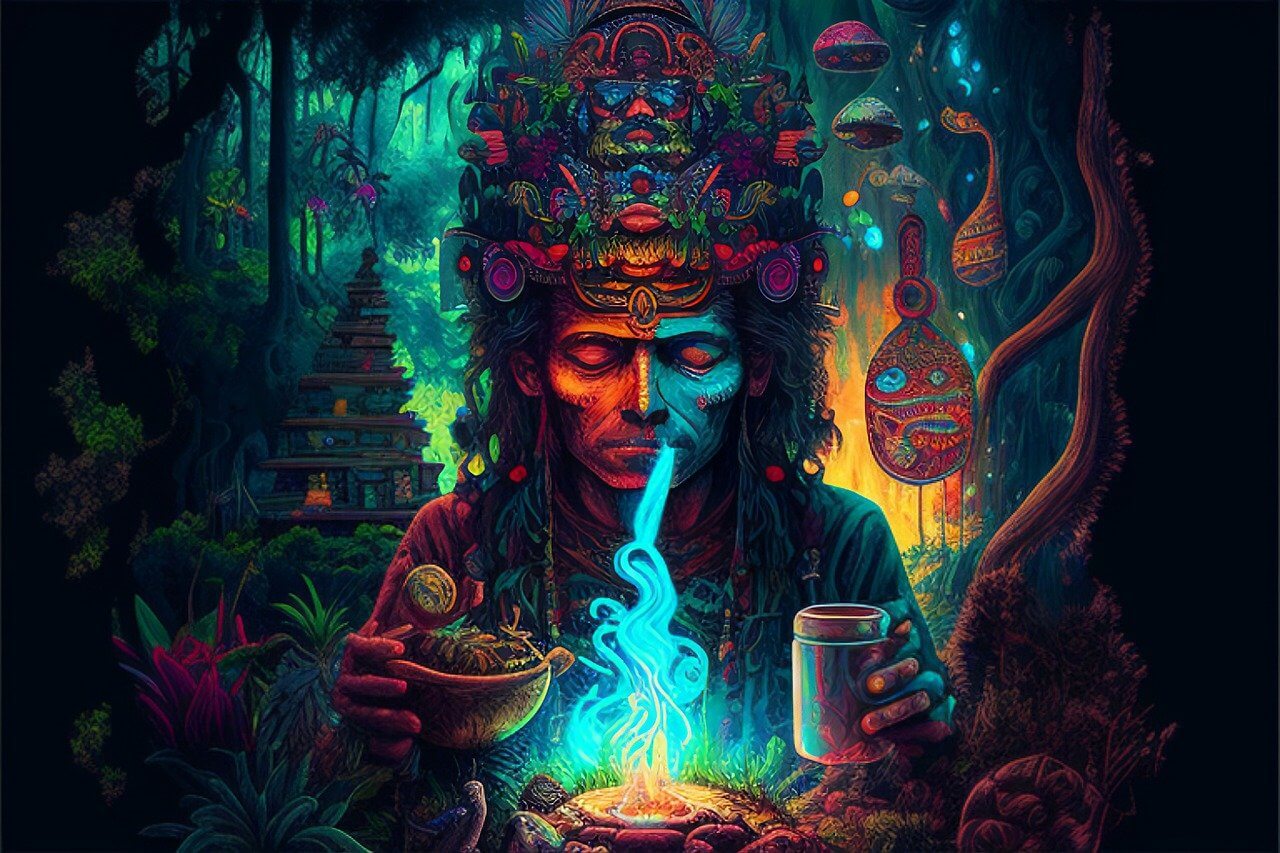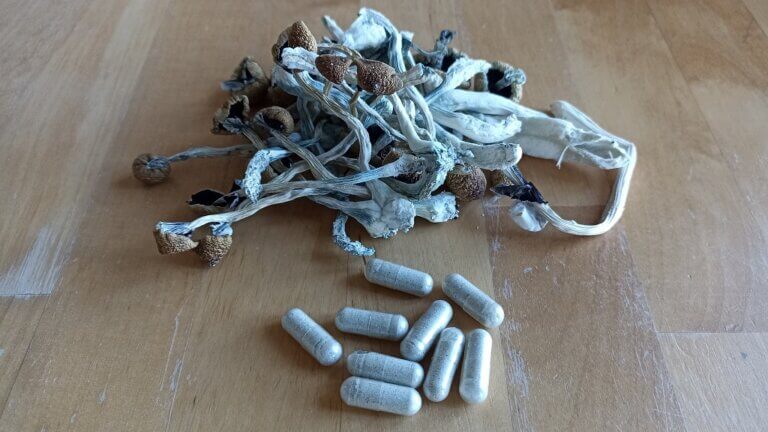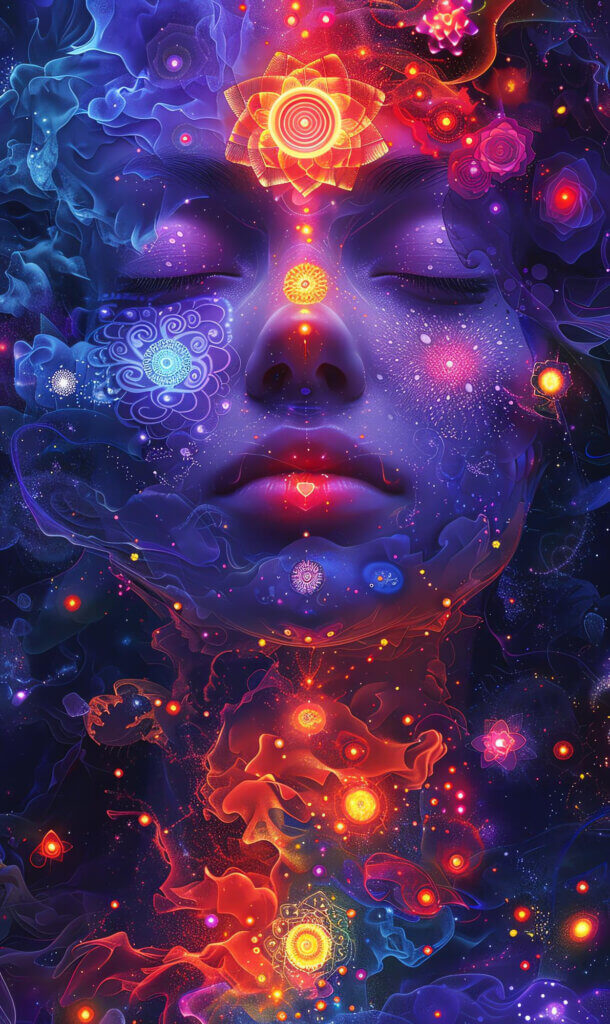Over the past few millennia, humans have been discovering and harnessing the properties of countless substances in nature, from plants that help facilitate the digestion of food to others that provide a series of psychoactive effects, thanks to which our most spiritual and transcendent side has been greatly expanded. From plants like cannabis to magic mushrooms, there are a large number of completely natural compounds that we have used to open the borders of our minds.
Today we are going to talk about one of these substances, undoubtedly one of the most powerful known. Exactly, we are talking about DMT, a compound present in some plants (and also in animals) that has been used for millennia in shamanic ceremonies and rituals in countries such as Bolivia, Brazil, Colombia, Ecuador, Panama, Peru, or Venezuela to access altered states of consciousness. Today we will tell you more about this interesting substance and its main properties.

What is DMT?
- Name: DMT, dimethyltryptamine
- Formula: C12H16N2
- IUPAC name: 2-(1H-indol-3-yl)-N,N-dimethylethanamine
- Molar mass: 188.274 g/mol
- Boiling point: 160°C (320ºF)
- Presence at room temperature: Colorless or slightly yellowish crystals
DMT or dimethyltryptamine is a naturally occurring psychedelic compound that is part of the tryptamine family and is considered one of the most potent psychedelic substances known. It is found naturally in various plants and can also be synthesized in the laboratory. Although it is produced endogenously in the brain of humans and other mammals in small quantities, DMT is most commonly found in various plant species, such as those used in the preparation of ayahuasca, a ceremonial drink used in Amazonian shamanic traditions in which plants rich in DMT are used – such as Psychotria viridis (chacruna), Psychotria carthagenensis (amyruca) or Diplopterys cabrerana (chagropanga or chaliponga) – along with others that inhibit the enzyme that breaks it down in the body, called monoamine oxidase.
In recent decades, DMT has gained notoriety in both recreational and scientific research for its ability to generate intense and profound mystical experiences in a short period of time, with potential therapeutic applications in areas such as the treatment of depression or anxiety disorders. Recent clinical trials are also investigating its ability to induce neuroplasticity, which could improve neuronal connection and brain growth. In addition, some studies suggest that DMT may offer profound spiritual experiences that have long-lasting psychological benefits, helping patients process trauma or improve their emotional well-being.
Research has also begun to better understand how DMT interacts with serotonin receptors in the brain, producing visions and profound alterations in the perception of reality. Although still in the early stages, interest in the clinical benefits of DMT continues to grow. Legally, DMT is considered a controlled substance in many parts of the world, and its possession or use is often restricted and controlled.

DMT synthesis
Natural DMT is extracted from plants that contain this substance, mainly from the Fabaceae and Rubiaceae families. To give just a couple of examples of the dozens of plants that contain it, plants such as Mimosa hostilis and Psychotria viridis are common sources of this entheogenic compound. The extraction of DMT requires chemical processes that separate the alkaloid from the plant compounds using solvents, under controlled conditions to prevent the decomposition of the compound. The most common areas where this molecule is found in plants are:
- Leaves: In plants such as Psychotria viridis (one of the components of ayahuasca), DMT is concentrated in the leaves.
- Roots and bark: Some species, such as Acacia and Mimosa hostilis, have concentrations of DMT in their roots and bark.
- Seeds: In some plants, such as certain varieties of Anadenanthera, DMT is found in the seeds.
In the laboratory, DMT synthesis involves creating the compound from precursors such as tryptamine, which is then subjected to a reaction with a methylating agent (such as formaldehyde). This process is technically more complex than natural extraction but allows for purer DMT. Synthetic DMT is chemically identical to natural DMT, but purity and concentration can be easier to control under laboratory conditions.

The stoned ape theory: evolution and psilocybin
Do you know the stoned ape theory? Do you think that the consumption of substances such as psilocybin could have changed the evolution of the brain and the cognitive processes of our hominid ancestors? Today we are going to investigate this interesting theory, we will see where it comes from and how it has been received by the scientific community. Will you join us?
How is DMT consumed?
DMT can be consumed in a variety of ways, which influences the intensity and duration of its effects. Traditionally, and excluding ayahuasca as a drink, DMT was smoked, although in recent years there has been an increasingly popular use of vaporizers for this purpose. Yes, the same vaporizers, bubblers and pipes that are usually used to consume cannabis and/or its extracts are commonly used to consume DMT. Broadly speaking, these are some of the most popular consumption methods:
- Smoking or Vaporizing: This is the most common method. DMT is placed in a vaporizer or pipe, heated to a high temperature, and inhaled. The effects are almost immediate, peaking within a few minutes, and the experience lasts between 5 and 15 minutes. It is known to produce a deep and intense “trip,” where users experience kaleidoscopic visualizations and often feelings of transcendence.
- Injected: In medical or research settings, DMT can be administered intravenously. This method ensures accurate dosing and rapid absorption. Although not a common method among recreational users, it has been used in scientific studies to observe the effects of DMT under controlled conditions. The effect is also immediate, but its duration and ability to measure the exact dose make it useful for clinical experiments.
- Oral (Ayahuasca): When DMT is taken orally, it is not active on its own because it is quickly broken down by the body. However, as you may know, in combination with a monoamine oxidase inhibitor (MAOI), such as in Ayahuasca, DMT becomes bioavailable and the effects last 4-6 hours. Ayahuasca is a traditional South American brew used in shamanic ceremonies and contains both DMT (usually extracted from plants such as Chacruna or Chaliponga) and MAOIs from the Banisteriopsis caapi vine.
- Vapes and e-cigarettes: Recently, DMT has also been used in vaping cartridges, making it easier to administer and allowing for smoother dosing control. This method is popular with those who want discreet and convenient consumption, without the need for more complex vaporizers.
- Insufflation (snorting): It is possible to consume DMT in crystal or powder form by insufflation, although this method is uncommon. The effects are longer lasting compared to smoking but tend to be less intense.
Each of these consumption methods affects both the length and intensity of the psychedelic “trip,” so users often choose one over the other based on their desired experience and prior knowledge of the substance.
DMT flavor, aroma, and applications
The taste of DMT is described as intense, chemical, and unpleasant, often resembling burnt plastic or metal, which can make it difficult for some people to consume. Its aroma is similarly strong and pungent, which distinguishes it from other psychoactive compounds. When it comes to ayahuasca, is a reddish-brown drink, although the color can vary depending on the recipe used.
In terms of its applications, DMT has been used in ceremonial contexts, such as in ayahuasca, where it is mixed with other MAO (monoamine oxidase)-inhibiting plants, allowing for a prolonged and deeper experience. In addition, DMT is being investigated for its therapeutic potential to treat mental disorders such as depression, anxiety, and post-traumatic stress, as it is believed that it could help people re-evaluate their problems and traumas from a new perspective.

How to microdose psilocybin
In recent years you have probably heard of psilocobin microdosing. As its name indicates, these are very low doses of mushrooms rich in this alkaloid, below what is necessary to show obvious effects in the user, but which offer a series of benefits. Today we show you how to prepare them in comfortable capsules, step by step and in a very simple way.
Effects of DMT
The effects of DMT are known to be extremely potent and fast-acting, with the effects starting within seconds of inhalation or injection, peaking in 1-2 minutes, and wearing off completely in about 15-30 minutes. Despite this short duration, the effects are often perceived as deeply transformative. However, as we have already seen, depending on the method of administration the effect can be more or less potent, as well as longer or shorter lasting. However, as we have already seen, if DMT is taken orally in the form of ayahuasca the effect is equally potent but can last up to 6 hours, so be careful, this is not just about eating a few mushrooms for a laugh!
Users often report experiencing geometric visions, intense colors, and intricate patterns that move and shift. Also common is the feeling of having been transported to another dimension or reality, often in the company of non-human entities or beings. These encounters are often described as deeply spiritual or mystical. Other effects include a strong dissociation from the body, a distortion in the perception of time, and in some cases, extreme emotions, ranging from euphoria to fear.

5-MeO-DMT, a close relative of DMT
5-MeO-DMT (5-methoxy-N,N-dimethyltryptamine) is a potent psychedelic compound found in several plants and the venom of the toad Bufo alvarius. For example, it can be found in the seeds of Piptadenia colubrina and the bark of Dictyoloma incanescens. It is considered structurally similar to DMT but with more intense and shorter-lasting effects. It produces deeply introspective and transcendental experiences, often described as “ego-dissolving.” In its natural synthesis, it is found in several plant species, and in laboratories, it can be obtained through chemical processes. It has gained popularity in the therapeutic and spiritual realm, although its use carries significant risks. If you’ve read our article on Myke Tyson and cannabis, the name probably sounds familiar to you, as good old Mike has described his experiences with this compound on several occasions.
Plants rich in DMT
As we already know, DMT is present in various plants and plant species, although depending on the plant it may be found in one part or another of it, such as in the leaves or seeds. Among the best-known, the following stand out:
- Psychotria viridis: A fundamental part of ayahuasca, this plant contains high levels of DMT and is combined with others to prolong its effects.
- Mimosa hostilis: With a high concentration of DMT in its root, it is used for the extraction of the compound in an artisanal manner and in ceremonies.
- Acacia confusa: A DMT-rich tree, widely used in Southeast Asia for both ceremonial purposes and extractions.
- Diplopterys cabrerana: Another key plant in the preparation of ayahuasca, highly valued for its high DMT content.
- Desmanthus illinoensis: Known as “Illinois root,” this plant contains DMT in its roots and is used in traditional shamanic preparations.
These plants have a long history of spiritual and medicinal use and are currently being studied for their potential in psychedelic therapy to treat common problems such as anxiety and depression.
Let the research continue!
References:
- DMT: Alcaloide, Espíritu Sagrado, Alì Cortina
- Ayahuasca: N, N-dimetiltriptamina (DMT) una Herramienta Psicodélica con Posibles Propiedades Psicoplastogénicas, Fernando Alcino Da Silva Ponciano, Heulália Teodora Cerqueira Gonçalves
- DMT: The Spirit Molecule: A Doctor’s Revolutionary Research into the Biology of Near-Death and Mystical Experiences, Rick Strassman
Source link
#DMT #dimethyltryptamine #Alchimia #Grow #Shop